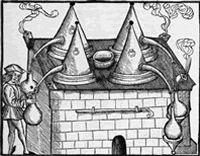|
Syllabus ref: 10.2 Syllabus ref: 20.1 Syllabus ref: 20.2 Synthesis means making something new. In chemistry the term applies to preparation of compounds from other starting materials. The complex nature of many organic compounds means that their synthesis often must go through several steps before the final product is achieved. |
|
Reaction
Synthesis involves several steps designed to make the maximum amount of product with the highest purity that is reasonably possible.
The first stage is to decide on which reactants will make your product. This is often requires more than one stage and a chemist would have to carefully consider all stages when deciding on a pathway.
Factors to consider
- Reaction feasibility
- Reaction rate
- Ease of separation
- Yield
Feasibility
The reaction feasibility is known by considering the various types of reactions that the common functional groups undergo. These can be drawn up into pathways such as the diagram below. You have to learn the most common pathways that are available for simple transformations.
You can see from the scheme that a step from alkene to alkane is reasonable, whereas a direct step from alkene to carboxylic acid is not. This does not mean to say that it is impossible, only that it is not the route of choice, for reasons of simplicity, rate and yield.
Reaction rate
Organic reactions involve breaking and making strong covalent bonds. This often needs large amounts of energy and a reaction mixture may require heating for extended periods of time. Organic substances are often volatile, so techniques such as reflux must be employed that allow heating without losing the reactants by evaporation.
In the preparation of trinitrobenzene for example, benzene in heated for several hours under reflux with a concentrated nitric and sulfuric acid mixture.
Separation
The extreme conditions used in organic synthesis coupled with similarities of bond strength, means that there is often a mixture of products formed, only one of which is required. The final product must be separated from the reaction mixture and the other undesirable products (by-products). This separation invariably loses some of the required product no-matter how carefully it is carried out. In some cases the separation required is so complicated as to make the reaction itself unviable.
|
Example: the reaction between methane gas and chlorine in UV light The reaction proceeds via a free radical mechanism and produces a complex mixture of products including: chloromethane, dichloromethane, trichloromethane, tetrachloromethane, ethane and several chloroethanes. It is important for this reason to restrict the amount of chlorine available, to limit the amount of di- and trichloro substituted methanes formed. |
Yield
The percentage yield is defined as the actual mass produced (actual yield) divided by the theoretical mass (theoretical yield assuming perfect reaction and perfect separation) multiplied by 100 (to make a percentage).
![]()
The percentage yield depends on the above of reaction and separation efficiency factors.
Separation
The separation procedure is sometimes called 'the work-up'. The required product needs to be separated from the reaction mixture and any by-products that may be present. There are a variety of techniques available depending on the quantities involved and the nature of the product mixture.
- Filtration
- Distillation
- Chromatography
- Solvent extraction
Filtration is used to separate a solid from a liquid or solution.
Distillation is used to separate a volatile liquid from a mixture. Fractional distillation may be used for a mixture of volatile liquids.
Chromatography is used to separate mixtures of soluble solids or volatile liquids. It may be carried out in a chromatography column using a solid support phase, or in a gas stream.
Solvent extraction relies on the abiity of one substance to dissolve in an extracting liquid, which is then separated from the mixture physically using a separating funnel. The extracted solution may be shaken with a drying agent to remove water and then the product separated from the solvent by distillation.
Purification
Methods of purification depend on whether the product is solid or liquid. Purification means removing all of the substances that could be contaminating the final desired product.
A pure solid has a melting point very close to the literature figure and melts over a small range of temperatures (sharp). Impure solids have lower melting points than the literature value and broad melting ranges. Impure liquids have higher boiling points than the literature value.
Solids can be recrystallised (several times) from a suitable solvent and the solvent removed by drying on filter papers, in an oven, or in a dessicating jar (drying jar). Solids may also be purified by chromatography
A liquid is redistilled as many times as required, either at normal atmospheric pressure or, if the liquid may decompose, at reduced pressure.
Volatile liquids can be purified by gas chromatography


